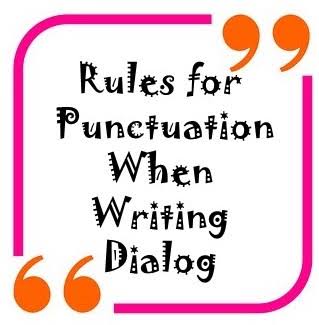Nothing identifies a novice fiction writer more quickly than incorrectly punctuated dialogue. Many students might benefit from a fiction writing course if they intend to write in this genre, given the majority of academic articles do not have dialogue.
Be sure to review punctuation and grammatical rules before beginning a work of fiction to ensure that your writing is easily understood and well-received. Read on for the correct dialogue punctuation rules, common mistakes of dialogue punctuating and tips.

Do’s
To have a correct dialogue punctuation, make sure to do these:
- Use commas and periods inside quotation marks.
- Add a period after a quotation before the next quotation.
- Always italicize words used in interior discussion.
Don’ts
If you want a correct dialogue punctuation in your writings, do not do these:
- Placing commas and periods outside quote marks.
- Comma-separate two quotations.
- Using end quotation marks at the conclusion of the first paragraph if the second paragraph is also a quote.
Also Read: 40+ Effective Survey Questions for Learning Assessment
Common Punctuation Errors in Conversation
Incorrect punctuation and formatting of dialogue is prevalent among novice fiction writers. The most frequent error is the usage of quotations outside of spoken language. Remember that only the person’s actual words should be included within the quote marks. Here are two other frequent dialogue errors to avoid.
Commas Between Two Sentences of Dialogue
People also wrongly compose dialogue by using a comma instead of a period between two sentences.
- Incorrect: “I have made up my mind,” she said nodding, “I do not want to marry him.”
- Correct: “I have made up my mind,” she said, nodding. “I do not want to marry him.”
Punctuation and Spacing
As part of the dialogue, the exclamation mark should be placed within the citation in this instance.
- Incorrect: “Surely she has gone mad”! she said.
- Correct: “Surely she has gone mad!” she said.

Correct Dialogue Punctuation Rules
Get the upper hand! Learn these correct dialogue punctuation guidelines to avoid making blatant errors:
- Use a comma between the conversation and the tagline (“he said/she said”): “I would like to go to the beach this weekend,” she told him as they left the apartment.
- In American writing (the British have slightly different rules), periods and commas go inside quotation marks; other punctuation—semicolons, question marks, dashes, and exclamation points—belong outside unless it directly relates to the material within the quotes, as in the following example from Raymond Carver’s short story: “Where I’m Calling From”: “I don’t want any stupid cake,” says the guy who goes to Europe and the Middle East. “Where’s the champagne?” he says, and laughs. In the next example, the question mark goes outside the quotation marks because it is not part of the material being quoted: Did he say, “We should all go to the movies”? Also note that the sentence ends with only one mark of punctuation: the question mark. In general, don’t use double punctuation marks, but go with the stronger punctuation. (Question and exclamation marks are more powerful than commas and periods. If it helps, think of it as a game of Rock, Paper, Scissors.)
- Taglines that interrupt a sentence should be separated by commas. Note that the first letter of the second half of the sentence is in lowercase, like in the following example from “Greenleaf” by Flannery O’Connor: That is,” Wesley said, “that neither you nor me is her boy.”
- Use single quotes to indicate a quotation within a quotation. Example: “Have you read ‘Hills Like White Elephants’ yet?” he asked her.
- Italics are okay for interior discussion; just be consistent. Do I really love her? he thought.
- If a quotation spans multiple paragraphs, end quotes should not be used at the end of the first paragraph. Use them solely at the conclusion of a character’s speech: “and in the end, I didn’t even love her, I did think of marrying her, though.”

FAQs about Correct Dialogue Punctuation
Why is precise punctuation of dialogue so important?
Punctuating dialogue may not sound like a particularly interesting or enjoyable topic for a writer to study, but it is crucial for ensuring that your language exchanges between characters make sense to your audience. Good punctuation will help readers connect with your characters and strengthen your writing.
What is the proper punctuation for dialogue?
Dialogue is indicated by quotation marks at the beginning and finish. Typically, dialogue will include a dialogue tag to indicate who is speaking. Within the quotation marks, you would use standard punctuation, such as commas, periods, question marks, and exclamation points.
Why do some authors not use quotation marks?
Some argue that writing without quote marks is more elegant and makes the reading process simpler. Others argue that it is the author's intention to blur the distinction between dialogue and description, allowing the reader to build his or her own interpretation of the text.
Why do Poets occasionally avoid punctuation?
The absence of punctuation (such as periods, commas, etc.) in a poem emphasizes the free flow of emotion or lack thereof throughout the poem. If the poem is about someone walking along a road, the absence of punctuation emphasizes the path's continuity.
Final Words on Correct Dialogue Punctuation
You’re not different from other writers whom you admire their works, you can also be a great writer and thread a nice fiction apparel by putting into practice the correct dialogue punctuation rules. Keep writing and don’t drop the pen!
TOP PICKS FOR YOU:
- 10 Positive Aspects about the Future of Nursing Career
- 8 Great Advantages for Becoming A Male Nurse Practitioner
- So, you want be a Pilot? Do you know the Aircraft Navigation Terms and Meanings? Check these 70 terms
- 10 Best Video Conferencing Tools for Your Business
- Maintaining a Balanced Diet in School: 3 Foods to Avoid
